(A) 1 bacterial classification schemes new
•Télécharger en tant que PPT, PDF•
11 j'aime•10,330 vues
Signaler
Partager
Signaler
Partager

Recommandé
Contenu connexe
Tendances
Tendances (20)
Basics in Identification of Bacteria by Dr.T.V.Rao MD

Basics in Identification of Bacteria by Dr.T.V.Rao MD
En vedette
En vedette (20)
Homeostasis,cell physiology -- By Prof.Dr.R.R.Deshpande

Homeostasis,cell physiology -- By Prof.Dr.R.R.Deshpande
Chapter 4 isolation identification-and-cultivation

Chapter 4 isolation identification-and-cultivation
Similaire à (A) 1 bacterial classification schemes new
Similaire à (A) 1 bacterial classification schemes new (20)
UNIT 1 Introduction to Prokaryotes, Eukaryotes, Morphological Classification ...

UNIT 1 Introduction to Prokaryotes, Eukaryotes, Morphological Classification ...
Plus de Alia Najiha
Plus de Alia Najiha (20)
basic principles and protocol in plant tissue culture

basic principles and protocol in plant tissue culture
Dernier
Dernier (20)
Handwritten Text Recognition for manuscripts and early printed texts

Handwritten Text Recognition for manuscripts and early printed texts
The 7 Things I Know About Cyber Security After 25 Years | April 2024

The 7 Things I Know About Cyber Security After 25 Years | April 2024
Tech Trends Report 2024 Future Today Institute.pdf

Tech Trends Report 2024 Future Today Institute.pdf
[2024]Digital Global Overview Report 2024 Meltwater.pdf![[2024]Digital Global Overview Report 2024 Meltwater.pdf](data:image/gif;base64,R0lGODlhAQABAIAAAAAAAP///yH5BAEAAAAALAAAAAABAAEAAAIBRAA7)
![[2024]Digital Global Overview Report 2024 Meltwater.pdf](data:image/gif;base64,R0lGODlhAQABAIAAAAAAAP///yH5BAEAAAAALAAAAAABAAEAAAIBRAA7)
[2024]Digital Global Overview Report 2024 Meltwater.pdf
Exploring the Future Potential of AI-Enabled Smartphone Processors

Exploring the Future Potential of AI-Enabled Smartphone Processors
ProductAnonymous-April2024-WinProductDiscovery-MelissaKlemke

ProductAnonymous-April2024-WinProductDiscovery-MelissaKlemke
Automating Google Workspace (GWS) & more with Apps Script

Automating Google Workspace (GWS) & more with Apps Script
TrustArc Webinar - Stay Ahead of US State Data Privacy Law Developments

TrustArc Webinar - Stay Ahead of US State Data Privacy Law Developments
Mastering MySQL Database Architecture: Deep Dive into MySQL Shell and MySQL R...

Mastering MySQL Database Architecture: Deep Dive into MySQL Shell and MySQL R...
IAC 2024 - IA Fast Track to Search Focused AI Solutions

IAC 2024 - IA Fast Track to Search Focused AI Solutions
Axa Assurance Maroc - Insurer Innovation Award 2024

Axa Assurance Maroc - Insurer Innovation Award 2024
What Are The Drone Anti-jamming Systems Technology?

What Are The Drone Anti-jamming Systems Technology?
Apidays Singapore 2024 - Building Digital Trust in a Digital Economy by Veron...

Apidays Singapore 2024 - Building Digital Trust in a Digital Economy by Veron...
Boost PC performance: How more available memory can improve productivity

Boost PC performance: How more available memory can improve productivity
(A) 1 bacterial classification schemes new
- 1. Topic 1 - BAcTERiAL cLASSiFicATioN ScHEMES 20/09/12 1
- 2. Topic content Characterisation of species Binomial system Problems of classification Phylogenetic classification 20/09/12 2
- 3. 20/09/12 3
- 4. Characterisation Why?..Great number and diversity of organisms. Classification: Grouping of related organism together. Many m/o look alike to be classified according to the structure Literally hundreds of bacterial species are small rods or small cocci. 20/09/12 4
- 5. 5
- 6. Basic Shapes Bacillus (rod-shaped) Coccus (spherical) Spiral Spirillum Vibrio Spirochete Figures 4.1a, 4.2a, 4.2d, 4.4a, 4.4b, 4.4c
- 8. Prokaryotic Cells: Shapes Average size: 0.2 –1.0 µm × 2 – 8 µm Most bacteria are monomorphic A few are pleomorphic Figure 4.7a
- 9. The Cell Wall Prevents osmotic lysis Made of peptidoglycan (in bacteria) Figure 4.6
- 10. Gram-Positive Bacterial Cell Wall Figure 4.13b
- 11. Gram-Negative Bacterial Cell Wall Figure 4.13c
- 12. Gram-positive Gram-positive Cell Wall Cell Wall Thick peptidoglycan Thin peptidoglycan Teichoic acids Outer membrane Periplasmic space Figure 4.13b–c
- 13. Motile Cells Rotate flagella to run or tumble Move toward or away from stimuli (taxis) Flagella proteins are H antigens (e.g., E. coli O157:H7)
- 14. Arrangements of Bacterial Flagella Figure 4.7
- 15. 20/09/12 15
- 16. History of Binomial Nomenclature Father of taxonomy? Two name system,Latin scientific name. Formal system of naming organisms Organizing,classifying and naming organisms into groups-according to the specific criteria. How to write these names?? Vibrio cholerae Staphylococcus sp E.coli 20/09/12 16
- 17. Genus and species Genus - capitalized species – specific epithet. Example: Escherichia coli,E.coli • Information gained: shape,who discovered,where it is found,what disease they cause. 20/09/12 17
- 18. 20/09/12 18
- 19. General problems Establishing a standard names for organisms so that we can communicate about them Usually classified according to their phylogenetic or evolutionary, but not always easy Leads to introduction of a dichotomous key 20/09/12 19
- 20. Dichotomous key Has paired statements describing characteristic of organisms Paired statement can only have one statement true Each paired statement relate to each other 20/09/12 20
- 21. 20/09/12 21
- 22. Dichotomous Key Figure 10.8
- 23. Reasons causing problems 1. Deciding what constitutes a species – because of some bacteria have the similar characteristics so taxonomist try to tolerate the organism within species 2. Deciding what constitutes a kingdom – because most of organism having sexually reproduction so have very factors affecting the variable of the characteristics 20/09/12 23
- 24. Focusing on bacterial classification Other organism categorized from domain to species, but for prokaryotic cell, start from strain to genus However facing problems reaching the classes and orders level Wide range of studies needed on identification and building up taxonomy of bacteria 20/09/12 24
- 25. 20/09/12 25
- 26. Phylogenetic hierarchy Grouping organism according to common properties that implies that a group of organisms evolved from common ancestors. Each species retains some characteristics of the ancestor. 20/09/12 MIC250 by Miss Rashidah Iberahim 26
- 27. Hierarchy domain – Bacteria kingdom – none assign for bacteria phylum – Proteobacteria class – Gamma-proteobacteria order – Enterobacteriales family – Enterobacteriacea genus – Eschericia Species – E.coli start 20/09/12 27
- 28. Three domain system classification 20/09/12 28
- 29. Terminologies (answer) Taxa – subdivisions used to classify organism: domain, kingdom, phylum Phylogeny / sytematic – the evolutionary history of a group of organism; phylogenetic relationships are evolutionary relationship Taxonomy – the science of the classification of organism 20/09/12 m 29
- 30. The enD Short lecture ,but!!! MAKE MORE revision on it…. TQ 20/09/12 30
